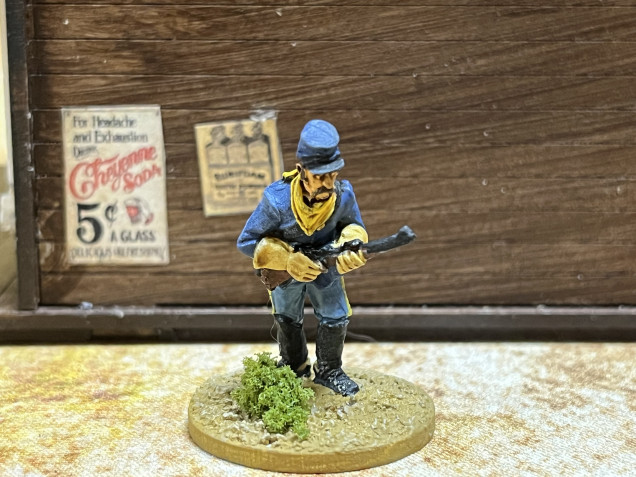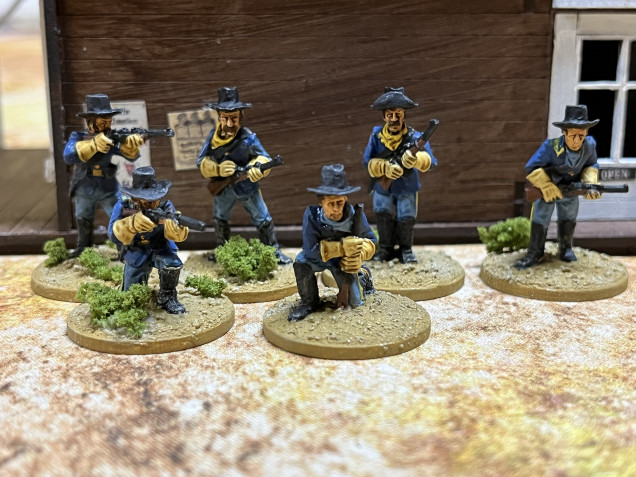
Building the Old West
The Horse Soldiers Pt 2
 Officer in civilian coat and civilian “Fireman” style bib front shirt. With no rank insignia visible, only the gold hat cord lets you know he’s an officer.
Officer in civilian coat and civilian “Fireman” style bib front shirt. With no rank insignia visible, only the gold hat cord lets you know he’s an officer.  Another officer. You can tell by the yellow shoulder boards. He’s wearing the 1872 undress pattern coat. Difficult to see but the front of the coat has black facings and black trim. The neckerchief is civilian clothing.
Another officer. You can tell by the yellow shoulder boards. He’s wearing the 1872 undress pattern coat. Difficult to see but the front of the coat has black facings and black trim. The neckerchief is civilian clothing.  Flag bearer. I’ll add the flag later. This enlisted man is wearing an 1872 pattern coat with vertical pleats that might be hard to see here. It was wildly unpopular and was discontinued in just a few years.
Flag bearer. I’ll add the flag later. This enlisted man is wearing an 1872 pattern coat with vertical pleats that might be hard to see here. It was wildly unpopular and was discontinued in just a few years.  Trooper wearing chasseur style cap. Common during the Civil War it was still issued with minor variations until the 1880s.
Trooper wearing chasseur style cap. Common during the Civil War it was still issued with minor variations until the 1880s.  This trooper has removed his coat and is fighting in the gray flannel undershirt. The yellow scarf was not an issue item despite what Hollywood films say. The scarves were all civilian items and would have come in all colors and patterns.
This trooper has removed his coat and is fighting in the gray flannel undershirt. The yellow scarf was not an issue item despite what Hollywood films say. The scarves were all civilian items and would have come in all colors and patterns.  This trooper is also fighting in his issue grey flannel undershirt. His blue shirt is also a civilian shirt. You can tell because the sleeves are rolled up, something that wouldn’t have been possible with the issue coat. The pants are probably the enlisted canvas fatigue uniform that was issued to protect the wool uniforms when doing manual labor around the post. The stripes wouldn’t be worn on this uniform so this trooper added them himself.
This trooper is also fighting in his issue grey flannel undershirt. His blue shirt is also a civilian shirt. You can tell because the sleeves are rolled up, something that wouldn’t have been possible with the issue coat. The pants are probably the enlisted canvas fatigue uniform that was issued to protect the wool uniforms when doing manual labor around the post. The stripes wouldn’t be worn on this uniform so this trooper added them himself. These uniforms were pretty much standard until 1885. These miniatures could also be used up to 1898 by not painting the yellow trim on the collars and changing the leg stripes to a darker yellow, almost orange color, for the later period.
































![How To Paint Moonstone’s Nanny | Goblin King Games [7 Days Early Access]](https://images.beastsofwar.com/2024/12/3CU-Gobin-King-Games-Moonstone-Shades-Nanny-coverimage-225-127.jpg)









































Leave a Reply